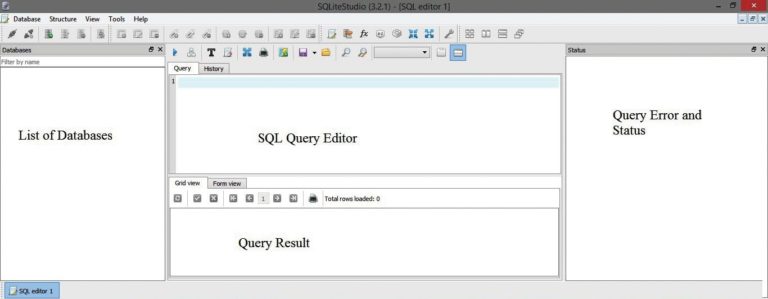
- #Open sqllite database with sql studio install#
- #Open sqllite database with sql studio software#
- #Open sqllite database with sql studio code#
- #Open sqllite database with sql studio download#
#Open sqllite database with sql studio install#
To install the driver, right-click the solution and go to “Manage NuGet Packages.” In the search bar, type “SQLite” and install the package that appears. Don’t forget to click “Manage NuGet Packages” from the pop-up menu. Install all required SQLite resources from the NuGet package, as pictured in Figure 1. To connect SQLite with C#, we need drivers. Open Visual Studio, select new project, and, in Visual C#, select “Console Application” and provide the name as SQLiteDemo. Let’s create a project in Visual Studio to demonstrate SQLite’s capabilities. Want to start working with SQLite but don’t know much C#? Visit The TechRepublic Academy Getting Started with SQLite from a.
#Open sqllite database with sql studio download#
Developers just have to download the library and add the data file in their application. To connect SQLite, no additional database drivers, or ODBC configuration are required. SQLite reduces application cost because content can be accessed and updated by using concise SQL queries instead of lengthy procedural queries. Reading and writing operations in SQLite database are extremely fast, almost 35% faster than any traditional databases. Most mobile and small device databases doesn’t need a server component SQLite is recommended for mobile-based applications.
#Open sqllite database with sql studio software#
Why SQLite in C#?ĭue to its lightweight structure, SQLite is heavily used in embedded software with devices such as TV, mobile phones, cameras, home electronic devices, and so forth.

#Open sqllite database with sql studio code#
The SQLite source code is public and is free for use for any purpose, commercial or private. All SQLite transactions are fully ACID compliant that means all queries and changes are Atomic, Consistent, Isolated, and Durable. Due to the serverless architecture, developers don’t need to install SQLite before using it. The SQLite database file format is cross-platform and can be copied between 32-bit and 64-bit file systems. A SQLite database is integrated with the application that accesses the database. Rather, it reads and writes data directly in disk files. It doesn’t have a separate server component like traditional databases. Once you are able to configure connection to a remote SQL Server, the same address (or server name) should connect OK from TimeXtender.SQLite is a small, fast, and embeddable open source file system-based SQL database. In the example below, all three connections refer to the same remote SQL Server. Now you can run SSMS on the client machine, connect to (remote) SQL Server by specifying its local or public IP address, or name. Add a SQL login (if not already there)ĥ. Enable SQL Service to listen on TCP/IPĬheck SQL Server version and run appropriate version of SQL Configuration Manager to enable TCP. Server Properties - > Connections -> Allow Remote Connections. Server Properties -> Security -> SQL Server and Windows Authentication mode (Enable)ģ. Run SSMS (SQL Server Management Studio) on SQL Server machine Read this article for details: Configure the Windows Firewall to Allow SQL Server AccessĢ. Windows Firewall ->Advanced Settings->Inbound RulesĪdd a rule to enable TCP port 1433 (default port for SQL Server) Take a note of server machine’s IP address. This article describes configuration steps to enable a SQL connection from a remote machine.īefore connecting TimeXtender to a remote SQL Server, you may use SQL Server Management Studio to verify the connections. It may also need SQL connections for staging and data warehouse. TimeXtender will need to connect to SQL Server on another machine to access Repository database. When TimeXtender is running on an Application Server, SQL Server is not installed on the same machine.


 0 kommentar(er)
0 kommentar(er)
